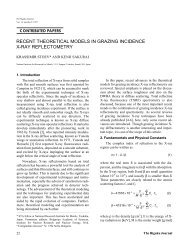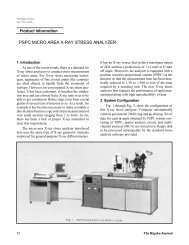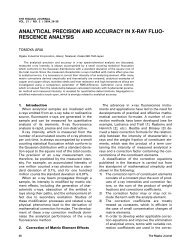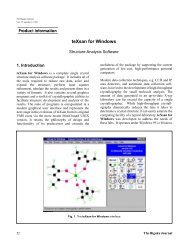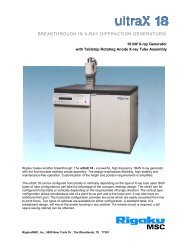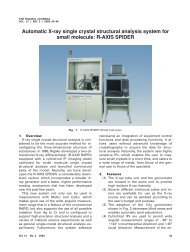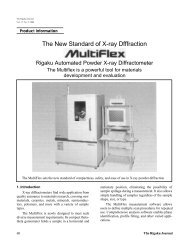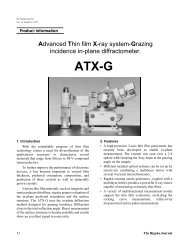Fluorescence X-ray Spectrometer System ZSX Series - Rigaku
Fluorescence X-ray Spectrometer System ZSX Series - Rigaku
Fluorescence X-ray Spectrometer System ZSX Series - Rigaku
Create successful ePaper yourself
Turn your PDF publications into a flip-book with our unique Google optimized e-Paper software.
The <strong>Rigaku</strong> Journal<br />
Vol. 16/ number 2/ 1999<br />
Product Information<br />
<strong>Fluorescence</strong> X-<strong>ray</strong> <strong>Spectrometer</strong> <strong>System</strong><br />
<strong>ZSX</strong> <strong>Series</strong><br />
The <strong>ZSX</strong>: Innovative XRF Technology-Accelerated.<br />
1 Introduction<br />
The <strong>ZSX</strong> is a revolutionary WDXRF system that<br />
combines innovative and powerful software with the<br />
best available hardware technology. <strong>ZSX</strong> software<br />
incorporates <strong>Rigaku</strong>'s long accumulated experience<br />
and expertise in X-<strong>ray</strong> spectrometry analysis with<br />
cutting edge technology. While the <strong>ZSX</strong> is built on<br />
solid, state-ofthe-art technology, it features a simple<br />
user interface. The novice is guided along with templates<br />
that cover everything from sample preparation<br />
to control samples. And, the experienced XRF analyst<br />
can utilize the same interface to operate independently<br />
with a full suite of analytical capabilities. <strong>ZSX</strong> software<br />
contains the most advanced FP program available<br />
and its EZ scan program allows rapid measurement<br />
of unknown samples with no prior setup.<br />
The <strong>ZSX</strong> hardware incorporates the best available<br />
technology for high-sensitivity and high-resolution<br />
measurements. Its design incorporates modular components<br />
that allow a wide variety of configu-rations.<br />
This design means that the <strong>ZSX</strong> is capable of<br />
hardware upgrades on site. The <strong>ZSX</strong> can be configured<br />
with normal (tube above) or inverted (tube below)<br />
optics and high-powered side or end window X-<strong>ray</strong><br />
tubes. Its flexible layout means that valuable laboratory<br />
space can be saved by remote location of the<br />
X-<strong>ray</strong> generator and heat exchanger.<br />
<strong>ZSX</strong> Options include an R-Theta sample stage, a<br />
CCD camera and mapping capability for easy and<br />
rapid surface mapping for contamination testing.<br />
Micro-area analysis is possible down to 0.5 mm; and,<br />
with the exclusive high focus end window tube and<br />
high sensitivity optical system, there is a 10X increase<br />
in intensity when compared to existing micro area<br />
analysis systems offered.<br />
The optional X-Y automatic sample changer<br />
provides quick and reliable sample transport with or<br />
without sample cups. Applications Packages that<br />
provide turnkey solutions to applications problems,<br />
such as steels, brass, oils, refractories and cement, are<br />
also available.<br />
2. Features<br />
(1) A new 3-axis (2-22-22) goniometer makes it<br />
possible to select a detector arrangement according to<br />
the analysis objective, specifically, high-sensitivity<br />
analysis or high-resolution analysis.<br />
(2) Accurate mapping and point analysis can be<br />
realized with the use of a CCD camera. This enables<br />
the operator to identify faulty portions of the sample<br />
58 The <strong>Rigaku</strong> Journal
with CCD viewing and to specify the location of<br />
analysis simply by a click of the mouse.<br />
(3) A new r-2 stage is employed to allow<br />
microarea analysis with optimized conditions. In<br />
mapping and point analysis, there is no effect from the<br />
unevenness of radiation from the X-<strong>ray</strong> tube or from<br />
reflection with the analyzing crystal.<br />
(4) The <strong>ZSX</strong> produces wavelength dispersive X-<br />
<strong>ray</strong> fluorescence analysis with a measurable sample<br />
diameter down to 50 :m.<br />
(5) A variety of X-<strong>ray</strong> tubes are available<br />
including a 30 :m thin window X-<strong>ray</strong> tube featuring<br />
high sensitivity for light elements and an X-<strong>ray</strong> tube<br />
optimal for small diameter samples.<br />
(6) A t<strong>ray</strong> system incorporated in the ASC<br />
(automatic sample changer) facilitates the control and<br />
conveyance of samples.<br />
(7) The revolutionary software package contains a<br />
full suite of analysis capabilities with a simple,<br />
straightforward user interface.<br />
(8) Windows NT Operating <strong>System</strong>.<br />
3. Application Field<br />
Application fields and specific examples are listed<br />
below.<br />
Applications Examples<br />
Electronics and<br />
magnetic<br />
Chemical industry<br />
Ceramics<br />
Steel<br />
Nonferrous metals<br />
Mining<br />
Petroleum, coal<br />
Environmental analysis<br />
Other<br />
4. Optical <strong>System</strong><br />
LSI, memory disk, CRT parts, magnetic<br />
materials<br />
Catalyst, polymer, pharma ceuticals,<br />
fertilizer, pigment, paint, oil & fat,<br />
detergent, cosmetics<br />
Silicon nitride, alumina, glass,<br />
refractories, enamel, cement<br />
Special steel, surface treat ment steel<br />
plate, ferroalloy, cast iron, cast steel,<br />
iron ores, plating liquid<br />
Aluminum, shape memory alloy, copper<br />
alloy, precious metal, Ni alloy, solder,<br />
plating liquid<br />
Ore, rock, volcanic ash<br />
Grease, lubricant, cutting oil, kerosene,<br />
heavy oil<br />
Waste water, seawater, river water, airborne<br />
dust, in- dustrial wastes<br />
Soil , rock, plant, organisms, foodstuff<br />
Fig. 1 shows the optical system of the <strong>ZSX</strong>. When<br />
a sample is irradiated with the primary X-<strong>ray</strong> beam<br />
from an X-<strong>ray</strong> tube, fluorescent X-<strong>ray</strong>s whose<br />
Fig. 1. New Optics of <strong>ZSX</strong><br />
Vol. 16 No. 2 1999 59
wavelengths are characteristic of the elements in the<br />
sample will transpire. These secondary X-<strong>ray</strong>s then<br />
undergo spectral processing with the analyzing crystal<br />
and are detected by the detector (SC, F-PC). The <strong>ZSX</strong><br />
Fig. 2. Sensitivity Comparison Profiles in Offset<br />
Arrangement and Tandem Arrangement.<br />
is equipped with a 3-axis (2-22-22) independent<br />
driving goniometer. This allows for the selection of<br />
the offset arrangement for high-resolution analysis or<br />
for the tandem arrangement for high-sensitivity<br />
analysis (SC+F-PC arranged in series).<br />
The SC detector can be equipped with an optional<br />
high-sensitivity slit. This can be installed in addition<br />
to the standard high-resolution slit. This allows an<br />
optimal combination to meet the desired analytical<br />
requirement. Fig. 2 shows a sensitivity comparison<br />
chart for the tandem arrangement. The sample<br />
chamber employs a double vacuum system. A<br />
preliminary vacuum chamber is also provided to<br />
enable evacuation for a subsequent sample while<br />
measurement of the current sample is occurring.<br />
5. r-2 Sample Stage and CCD Point Analysis<br />
Figure 3 depicts the X-<strong>ray</strong> intensity distribution<br />
that takes place with the primary X-<strong>ray</strong>s. The<br />
conventional design enables the maximum X-<strong>ray</strong><br />
intensity to be obtained with a standard diameter<br />
sample. However, for small diameter samples, the<br />
measurement will occur at a position deviating from<br />
the maximum X-<strong>ray</strong> intensity. With the <strong>ZSX</strong>, the use<br />
Fig. 3. Sensitivity Comparison by use of the r-2 stage.<br />
60 The <strong>Rigaku</strong> Journal
Fig. 4. CCD Picture of Granite Sample and Comparison Chart.<br />
of the r-2 stage makes it possible to perform<br />
measurements at the maximum X-<strong>ray</strong> intensity<br />
position even for small diameter samples. And, when<br />
used with the CCD camera, this r-2 stage is especially<br />
effective for mapping processing by CCD viewing as<br />
well as for the analysis of a faulty portion on the<br />
sample.<br />
Figure 4 shows the point analysis result of a rock<br />
by the use of the r-2 stage along with the CCD camera.<br />
6. Software<br />
The <strong>ZSX</strong> software incorporates <strong>Rigaku</strong>'s<br />
longaccumulated experience and expertise in X-<strong>ray</strong><br />
spectrometry analysis with cutting edge technology. It<br />
is so easy to use that even a novice can quickly use it<br />
correctly. The <strong>ZSX</strong> software configuration is shown<br />
below.<br />
6.1. SQX(ScanQuantX)<br />
Software for computation covering qualitative<br />
analysis through semiquantitative values.<br />
6.2. EZ scan<br />
Sophisticated SQX analysis can be performed<br />
with five easy steps.<br />
6.3. Application packages<br />
Turnkey solutions for a variety of applications.<br />
These packages include standards set-up, optimal<br />
calibration curves and program check standards.<br />
6.4. Application templates<br />
The user is guided along the analysis with<br />
templates that incorporate steps from sample<br />
pretreatment methods to measuring conditions up<br />
to control samples.<br />
6.5. Universal standard samples<br />
A database of commercially available standard<br />
reference samples is already in place. No<br />
additional data entry work is necessary.<br />
6.6. Fixed-precision measurement<br />
If a required precision is entered, the analysis is<br />
carried out with the optimized measurement time<br />
for each of the unknown samples.<br />
6.7. Energy saving function<br />
The X-<strong>ray</strong> output can be automatically reduced<br />
according to the amount of instrument idle time.<br />
6.8. Automatic program run<br />
This provides system ON/OFF, resumption after<br />
power failure, auto aging, PR gas flow control,<br />
etc.<br />
6.9. Decision on material<br />
Retrieval of standards is made, such as the JIS<br />
(Japanese Industrial Standard), for instance.<br />
6. 10. E-mail transfer<br />
The analysis result, an error message, or other<br />
information can be e-mailed.<br />
6. 11. Remote control<br />
Remote-control operation can be made using<br />
LAN.<br />
6.12. Remote diagnosis<br />
Diagnosis of the system status can be made from<br />
the <strong>Rigaku</strong> service station through e-mail.<br />
6.13. Automatic selection of sample diameter<br />
Automatic setting of the optimum area limiting<br />
diaphragm is performed for a given sample<br />
diameter.<br />
Vol. 16 No. 2 1999 61
Fig. 5. <strong>ZSX</strong> Software Configuration<br />
7. Configuration, Specification<br />
X-<strong>ray</strong> generator<br />
<strong>ZSX</strong>100e <strong>ZSX</strong>101e <strong>ZSX</strong>100s <strong>ZSX</strong>101s<br />
Rated voltage & current<br />
Voltage: 60 kV<br />
Current: 150 mA (rkW spec.)<br />
100 mA or 80 mA (ekW spec.)<br />
(Upper limit of current value differs depending on<br />
the tube type).<br />
Voltage: 60 kV<br />
Current: 80 mA<br />
Max. Continuous Output 4 kW or 3 kW 3 kW<br />
Stability "0.005% (for input variation "10%<br />
Control<br />
Safety device (standard), energy saving run (standard), automatic program run (optional)<br />
X-<strong>ray</strong> spectrometer assembly<br />
X-<strong>ray</strong> tube<br />
Sample changer<br />
End window type<br />
Single target: Rh, W, Mo (3kW)<br />
Cr (2.4 kW)<br />
Thin window type: Rh (3kW, 4kW)<br />
Micro analysis handling type: Rh (4kW)<br />
Dual target: Rh/Cr (3/2.4 kW), Rh/W (3/3 kW)<br />
One sample feed, 12-turret, ASC48<br />
Side window type<br />
Single target: Rh, Cr, W, Mo, Au (3kW)<br />
Sample chamber<br />
Sample inlet: Air lock system<br />
Sample chamber inside turret: 2 positions with sample detector<br />
Sample size: 51 mm N x 30 mm H max. (<strong>ZSX</strong>100e/100s)<br />
51 mm N x 46 mm H max. (<strong>ZSX</strong> 101e/101s)<br />
Stage Spinner or r-2 driving Spinner<br />
Primary beam filter Select from Ti, Al, CU, Zr (2 kinds), and Fe One kind selectable from Ti, Al, Cu, Zr<br />
62 The <strong>Rigaku</strong> Journal
<strong>ZSX</strong>100e <strong>ZSX</strong>101e <strong>ZSX</strong>100s <strong>ZSX</strong>101s<br />
Area limiting diaphragm<br />
Divergence slit<br />
30 mm N fixed (no attenuator) or 35, 30, 25, 20, 10,<br />
3, 1, 0.5 mm N and attenuator exchanger<br />
(For spinner or r-2 driving)<br />
Standard resolution, 1 kind, fixed or slit exchanger<br />
Select from standard resolution, high resolution and<br />
ultralight element use<br />
30 mm N fixed (no attenuator) or 35, 30, 25, 20, 10<br />
mm N (no attenuator exchanger)<br />
(spinner)<br />
Standard resolution, 1 kind, fixed or slit exchanger<br />
Selection from standard resolution and high<br />
resolution<br />
Receiving slit<br />
Goniometer<br />
Crystal exchanger<br />
Analyzing crystal<br />
Detector<br />
Vacuum system<br />
Temperature stabilizer<br />
Option<br />
High resolution for SC (standard) high sensitivity for SC (optional), for F-PC (select for <strong>ZSX</strong>101e/101s)<br />
2-22-22 3-axis independent drive system<br />
Scan range: SC -1~118E (22)<br />
F-PC 7~148E (22)<br />
Scan speed: Max 1400E/min<br />
Step angle: 1E/1000, 2E/1000, 5E/1000, 1E/100, 2E/100, 5E/100, 1E/100<br />
Continuous scan: 0.1~240E /min (optional)<br />
10-crystal exchanger or 4-crystal exchanger<br />
Select from LIF(200) PET, Ge, TAP, RX-4, RX-9, RX-35, LiF (220)<br />
Select from RX-40, RX-45, RX-60, RX-70, RX-80<br />
For Ti~U: Scintillation counter (SC)<br />
For Be~Zn: Gas-flow proportional counter (F-PC)<br />
With center wire cleaner and gas density stabilizer<br />
High-speed vacuum system (2 vacuum pumps), or general-purpose vacuum system (1 vacuum pump)<br />
Temperature for control: 36.5EC"0.1EC<br />
Powder sample attachment, automatic He substitution device, PR gas switching device, remote diagnosis,<br />
remote control, mapping device, sample observation mechanism<br />
Vol. 16 No. 2 1999 63





